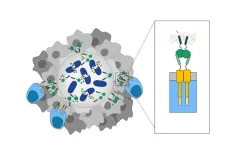(Press-News.org) In two parallel projects, researchers at Karolinska Institutet have been involved in creating the most comprehensive atlases of human brain cells to date. The two studies, which are published in Science, provide clues on different brain diseases and give hope for medical advancements in the future, such as new cancer drugs.
Knowing what cells constitute the healthy brain, where different cell types are located and how the brain develops from the embryo stage is fundamental to the ability to compare and better understand how diseases arise. There are at present advanced atlases of the mouse brain, but not for the human brain. Until now.
A brain-cell census
“We’ve created the most detailed cell atlases of the adult human brain and of brain development during the first months of pregnancy,” says Sten Linnarsson, professor of molecular system biology at the Department of Medical Biochemistry and Biophysics at Karolinska Institutet in Sweden. “You could say that we’ve taken a kind of brain-cell census.”
The first project was led by Kimberly Siletti from Linnarsson’s group. It was conducted in close collaboration with Ed Lein at the Allen Institute for Brain Science in Seattle, USA, as part of the international Human Cell Atlas initiative, and based on three donated human brains from adults. The researchers analysed more than three million individual cell nuclei using the technique of RNA sequencing, which reveals each cell’s genetic identity. All in all, the researchers studied cells from just over a hundred brain regions and found over 3,000 cell types, some 80 per cent of which were neurons, the remainder being different kinds of glial cells.
“A lot of research has focused on the cerebral cortex, but the greatest diversity of neurons we found in the brainstem,” says Professor Linnarsson. “We think that some of these cells control innate behaviours, such as pain reflexes, fear, aggression and sexuality.”
Groundwork for medical advances
The researchers could also see that the cells’ identity reflects the place in the brain where they first developed in the fetus, which links to the second project. Here, Emelie Braun and Miri Danan-Gotthold from Sten Linnarsson’s group collaborated with the Swedish consortium for the Human Developmental Cell Atlas to analyse over a million individual cell nuclei from 27 embryos at different stages of development (between 5 and 14 weeks of fertilisation). The study enabled the researchers to show how the entire brain develops and is organised over time.
Even though the results are examples of molecular biological basic research, the new knowledge generated can also lay the groundwork for medical advances. Professor Linnarsson’s research group has used similar methods to examine different kinds of brain tumours, one of which was a glioblastoma – a cancer with a poor prognosis.
“The tumour cells resemble immature stem cells and it looks like they’re trying to form a brain, but in a totally disorganised way,” he explains. “What we observed was that these cancer cells activated hundreds of genes that are specific to them, and it might be interesting to dig into whether there is any potential for finding new therapeutic targets.”
Freely available brain atlases
The brain atlases will be freely available to researchers around the world so that they can compare the brain diseases they are researching with what a normally developed brain looks like.
The studies are part of a larger package of articles published simultaneously in the scientific journal Science. The study on the adult brain was supported by a grant from the National Institutes of Health, while the embryo study was financed by the Knut and Alice Wallenberg and Erling-Persson foundations.
Sten Linnarsson is a scientific advisor at Moleculent, Combigene and Oslo University Center of Excellence in Immunotherapy. He and co-authors Alejandro Mossi Albiach and Lars E. Borm also hold shares in EEL Transcriptomics AB, which owns the intellectual property rights to the EEL method (“Spatial RNA localization”). Co-authors Žaneta Andrusivová and Joakim Lundeberg are scientific consultants for 10x Genomics, which holds the intellectual property rights to the Spatial Transcriptomics (Visium) technique.
Publication 1: “Transcriptomic diversity of cell types across the adult human brain”, Kimberly Siletti, Rebecca Hodge, Alejandro Mossi Albiach, Ka Wai Lee, Song-Lin Ding, Lijuan Hu, Peter Lönnerberg, Trygve Bakken, Tamara Casper, Michael Clark, Nick Dee, Jessica Gloe, Daniel Hirschstein, Nadiya V. Shapovalova, C. Dirk Keene, Julie Nyhus, Herman Tung, Anna Marie Yanny, Ernest Arenas, Ed S. Lein, Sten Linnarsson, Science, online 12 October 2023, doi: 10.1126/science.add7046.
Publication 2: “Comprehensive cell atlas of the first-trimester developing human brain”, Emelie Braun, Miri Danan-Gotthold, Lars E. Borm, Ka Wai Lee, Elin Vinsland, Peter Lönnerberg, Lijuan Hu, Xiaofei Li, Xiaoling He, Žaneta Andrusivová, Joakim Lundeberg, Roger A. Barker, Ernest Arenas, Erik Sundström, Sten Linnarsson, Science, online 12 October 2023, doi: 10.1126/science.adf1226.
END
Cell atlases of the human brain presented in Science
2023-10-12
ELSE PRESS RELEASES FROM THIS DATE:
Coffee and cocoa plants at risk from pollinator loss
2023-10-12
Tropical crops such as coffee, cocoa, watermelon and mango may be at risk due to the loss of insect pollinators, finds a new study led by UCL and Natural History Museum researchers.
Published in Science Advances, the study explores the intricate interplay between climate change, land use change, and their impact on pollinator biodiversity, ultimately revealing significant implications for global crop pollination.
The study, which compiled data from 1,507 crop growing sites around the world and catalogued 3,080 insect pollinator species, exposes a concerning trend – the combined pressures ...
Scientists unveil detailed cell maps of the human brain and the nonhuman primate brain
2023-10-12
A group of international scientists have mapped the genetic, cellular, and structural makeup of the human brain and the nonhuman primate brain. This understanding of brain structure, achieved by funding through the National Institutes of Health’s Brain Research Through Advancing Innovative Neurotechnologies® Initiative, or The BRAIN Initiative®, allows for a deeper knowledge of the cellular basis of brain function and dysfunction, helping pave the way for a new generation of precision therapeutics for people with mental disorders and other disorders of the brain. The findings appear in a compendium of ...
Engineered bacteria paint targets on tumors for cancer-killing T cells to see
2023-10-12
New York, NY—October 12, 2023—For several years, researchers have been successfully using chimeric antigen receptor (CAR) T cells to target specific antigens found on blood cells as a cure for patients with leukemia and lymphoma. But solid tumors, like breast and colon cancers, have proven to be more difficult to home in on. Solid tumors contain a mix of cells that display different antigens on their surface-often shared with healthy cells in the body. Thus, identifying a consistent and safe target has impeded the success of most CAR-T cell therapy for solid tumors at the first phase ...
How do tax proposals affect cancer health of tobacco users based on income, education?
2023-10-12
Tobacco is the leading cause of preventable death in the United States, according to the Centers for Disease Control and Prevention, and cigarette smoking causes three in 10 of all cancer deaths. Smoking also accounts for more than 30 percent of the difference in life expectancy among different socioeconomic groups.
Roberta Freitas-Lemos, research assistant professor at the Fralin Biomedical Research Institute at VTC, recently received a career development award to explore the ways in which nicotine tax policies can influence health disparities. The award of more than $680,000 over five years from the National Cancer Institute of the National Institutes of Health is designed ...
NIH awards Mount Sinai researchers $12 million to personalize sickle cell treatment
2023-10-12
New York, NY (October 12, 2023) - The Mount Sinai Health System has received a $12,180,625 grant from the National Heart, Lung and Blood Institute to compare new treatment options for sickle cell disease and determine which work best for specific patients.
“Sickle cell traditionally has been a neglected disease, but it benefited from a flurry of innovation over the last decade and there are now three new medications approved for the disease,” says Jeffrey Glassberg, MD, Director of the Mount Sinai Sickle Cell Program.
“While this is welcome news, clinicians now have a new challenge. ...
Caution: Content warnings do not reduce stress, study shows
2023-10-12
Advocates for the use of trigger warnings suggest that they can help people avoid or emotionally prepare for encountering content related to a past trauma. But trigger warnings may not fulfill either of these functions, according to an analysis published in Clinical Psychological Science, a journal of the Association for Psychological Science.
Instead, warnings appear to heighten the anticipatory anxiety a person may feel prior to viewing sensitive material while making them no less likely to consume that content, wrote Victoria M. E. Bridgland of ...
New catalyst could provide liquid hydrogen fuel of the future
2023-10-12
Researchers at Lund University in Sweden are investigating a car fuel comprised of a liquid that is converted to hydrogen by a solid catalyst. The used liquid is then emptied from the tank and charged with hydrogen, after which it can be used again in a circular system that is free from greenhouse gas emissions.
In two research articles, Lund researchers have demonstrated that the method works, and while it is still basic research, it has the potential to become an efficient energy-storage system in the future.
“Our catalyst is one of the most efficient around, at least if you look at publicly available research,” says Ola ...
Froedtert Health, Wisconsin Diagnostic Laboratories and HealthEco launch Atalan, a technology-enabled clinical partnership providing access to the best in laboratory medicine
2023-10-12
FROEDTERT HEALTH, WISCONSIN DIAGNOSTIC LABORATORIES AND HEALTHECO LAUNCH ATALAN, A TECHNOLOGY-ENABLED CLINICAL PARTNERSHIP PROVIDING ACCESS TO THE BEST IN LABORATORY MEDICINE
Atalan’s Access Hub Connects Doctors and Medical Centers to a Vetted Network of the Nation’s Foremost Clinical Laboratories to Improve Patient Diagnostics and Care
MILWAUKEE, Oct. 12, 2023 – Froedtert Health, Wisconsin Diagnostic Laboratories (WDL) and HealthEco announced today the launch of Atalan, a technology-enabled clinical partnership providing doctors and medical centers unprecedented access to a vetted network of the nation’s ...
Texas A&M-led team receives USDA grant to study cattle respiratory disease prevention
2023-10-12
Researchers from the Veterinary Education, Research, & Outreach (VERO) program at the Texas A&M School of Veterinary Medicine & Biomedical Sciences (VMBS) have received $300,000 from the United States Department of Agriculture’s National Institute of Food and Agriculture to study the costliest disease in the cattle industry, bovine respiratory disease (BRD).
The grant will fund a highly collaborative project involving Mississippi State University, West Texas A&M University and Texas A&M ...
$150M grants will drive new era in Alzheimer's treatments
2023-10-12
A new study will combine an Alzheimer’s medication that slows disease progression in some patients with two other drugs to see if their effects can be amplified. The trial will be the first to test drugs acting on two disease-driving proteins, amyloid and tau, for patients with late-onset Alzheimer’s, the most common type of dementia.
The trial will recruit 900 participants with early Alzheimer’s at UC San Francisco and other sites nationwide. It is funded by a grant from the National Institute on Aging, part of the National Institutes of Health. It is awarded to Adam Boxer, MD, PhD, principal investigator and project ...


